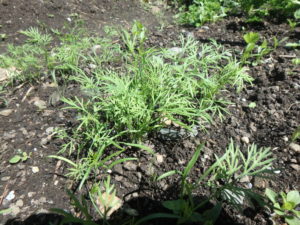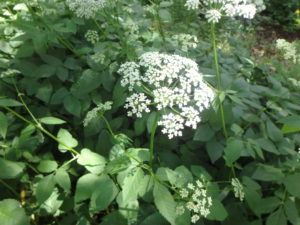Thinning, Weeding and Watering Made Easy
With the advent of summer, it is time to buckle down and get a few tedious jobs done in the garden. But there are ways to lighten your load.
First, it is time to thin out extra plants that are crowding each other. Carrots and beets are two common culprits of crowding, and if you want sizable root crops, you need to thin them.
Carrot seeds are tiny, so we don’t often plant them one-by-one. Instead we tend to sprinkle them and –by gum- most of them grow. I maintain that thinning carrots needs to happen by the Fourth of July, so get to work. If they are real close together, you may want to use scissors to cut off the extras at the soil line to avoid pulling up carrots you are trying to save.
One way to minimize the need to thin carrots is to buy pelleted seeds next time. These are seeds that come coated with a thin layer of clay. Each is the size of a BB and can be individually planted. Plant them an inch apart and you can skip the July 4th job. As they get bigger, you can eat the carrots you thin, giving them a 2-inch spacing by mid-summer.
Beet seeds are large and easy to plant. So why are there clumps of beets that need to be thinned out? It’s not that you forgot your reading glasses when planting. The answer is that those “seeds” are not really seeds. They are clusters of seeds wrapped in a package like an apple, or a pear. Johnny’s Selected Seed Company, and a few others sell ‘Moneta’ beet seeds, which have just one embryo per seed. Those, if you space them well at planting time, need not be thinned.
I like to be efficient at whatever I do, and that includes keeping a relatively weed-free garden. Many weeds quickly mature, flower, and produce seeds. Your job is to keep them from producing seeds. Right now goutweed – my nemesis – is blooming in various pockets around my garden, and I don’t have time to dig it all out. But I have a 16-year old helper who uses scissors to cut off all the flowers and bag them. We send them to the dump in black plastic bags.
Other weed control methods? Keep weeds from getting the sunlight they need to grow. You can do this by mulching. In the vegetable garden I spread out newspapers over the soil and cover them with straw, hay or leaves. Four to six pages of newspaper keeps out light, inhibiting weeds. Earthworms eat the paper over the summer, and newsprint is done with soy-based inks, so you are not adding heavy metals to your soil (which was the case years ago).
This method works well on walkways and around big plants, but is more problematical for onions and carrots which are small and closer together. I use grass clippings or chopped leaves, without the newspaper, around small plants.
Mulching in the flower garden is good, too. It keeps down weeds and holds in moisture. But beware: too much mulch can keep rain from reaching the roots of your perennials. An inch or two of ground bark helps a lot, but 3 or 4 inches will keep light showers from getting to the soil.
Some gardeners use landscape fabric under bark mulch, but I do not. I find pernicious weeds eventually send roots through the fabric and this makes weeding very difficult. Landscape fabric can also constrict perennials as they expand over time, choking them.
What about plain old black plastic? I don’t use it. Sunshine breaks it down over time, and makes a mess. It also keeps air and water from getting to the soil, which must affect soil microorganisms. But it will keep weeds down in a pumpkin patch for a single season. Still, the plastic ends up in the waste stream, which I want to avoid.
If we have a dry summer, you may need to water. Established perennials should not need added water, but your vegetable garden might. I don’t favor overhead sprinklers because they water everything: plants, walkways and weeds. I prefer a watering wand, which is a device I attach to my hose. It is a 30 inch aluminum wand with a sprinkler head and a valve. I can direct the water exactly where I want it. I like a brand called Dramm because the sprinkler head allows fast, gentle watering.
Watering cans are good, too. They allow you to see just how much water you are applying. This is important for new trees, which need 5 gallons a week or so. A sprinkler hose might seem like it is delivering a lot of water, but may not be.
A good timer will deliver water while you are away on vacation. They attach to your spigot and allow you to use an overhead sprinkler or a soaker hose. I have a soaker hose I like made by Water Right and available from Gardeners Supply Company (www.gardeners.com). It’s a round polyurethane hose, and much easier to use than the old fashioned flat ones I had tried previously.
So don’t let your garden dictate your vacation schedule. With mulch and a watering system you can come back from vacation with nothing worse than a lawn that needs cutting!
You may reach Henry at henry.homeyer@comcast.net or P.O. Box 364, Cornish Flat, NH 03746. Please include a SASE if you wish a reply by mail. Read Henry’s blog at https://dailyuv.com/





